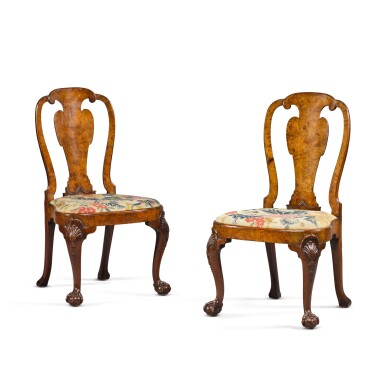
A pair of George II carved walnut and burr walnut veneered side chairs, circa 1730-40, attributed to Giles Grendey
Auction Closed
December 8, 05:58 PM GMT
Estimate
10,000 - 15,000 GBP
Lot Details
Description
A pair of George II carved walnut and burr walnut veneered side chairs, circa 1730-40, attributed to Giles Grendey
the vase shaped splat between scrolled uprights ending in a pronounced moulded shoe, with drop-in needlework compass seats, on cabriole legs headed by shell, bell-flower decoration ending in claw and ball feet, the drop-in seats numbered XIIII and VI and one rail stamped in three places RW
This pair of side chairs are a well-known model commonly attributed to Giles Grendey (1693-1780), one of the most preeminent cabinetmakers working in London during the first half of the 18th century. Stylistically they are closely related to a large suite of chairs and armchairs, some bearing Grendey's paper label on the back seat rail, formerly with the Copley (later Bewicke-Copley) family of Sprotborough Hall, Yorkshire, where three chairs and two armchairs were recorded in 1922, a few years before the house's demolition. The two sets share identical legs with shell carved knees terminating in claw and ball feet, and the Sprotborough set having more elaborately decorated backs with shell and acanthus carving on the splat and crest rail1.
Grendey's workshop is the likely author of several other recorded variants of the model supplied to important patrons, most notably a set of ten burr walnut side chairs incorporating a square covered seat centred by a stylized shell motif, but with identical legs and back to the present pair, and which were formerly in the highly important furniture collection of the Duke of Leeds at Hornby Castle, Yorkshire and offered in these rooms as part of Sir Joseph's collection (see Hotung, Part I | Evening, 7 December 2022, lot 33). A related set of eight walnut side chairs with identical backs to the Sprotborough Hall chairs but with trapezoid upholstered seats rather than compass-form drop in seats over a richly carved presentation seat rail, supplied to the Douglas-Pennant family at Penrhyn Castle, Gwynedd, Wales, sold Sotheby's London, Treasures, 5 July 2022, lot 11 (£151,200).
The present chairs are stamped ‘RW’ to the seat rails – likely to be the initials of the craftsman employed to make the chair – and while these initials are not among the recorded journeymen associated to Grendey commissions, it was common practice in his workshop2. The same stamp appears on a set of probably twelve chairs and a settee attributed to Grendey. Of that set, six chairs (plus the unstamped settee) are in the collection formed by Viscount Leverhulme, four were acquired in 1975 by Noel Terry for Fairfax House, York, and a further pair were sold Christie's, London, 25 June 1981, lot 25 (see L. Wood, The Upholstered Furniture in the Lady Lever Art Gallery, 2008, vol.I, no.20, pp.245-263).
Born in Wotton-under–Edge in Gloucestershire, Grendey was in London by 1709, when he was recorded as an apprentice to the joiner William Sherborne. His first workshop was at St. Paul's, Covent Garden, moving to premises in St. John's Square, Clerkenwell, in 1722, where he would remain for the rest of his working life. In addition to his furniture making activities Grendey was also an important timber merchant, and on the occasion of his wife's death in 1740 was described in a press notice as ‘a great Dealer in the Cabinet Way’. His businesses and professional reputation continued to flourish through the third quarter of the 18th century, his daughter marrying the cabinetmaker John Cobb in 1755, and Grendey himself becoming Master of the Joiners' Company in 1766. Grendey also distinguished himself among his peers by developing a significant client base abroad. Evidence for this is revealed in newspaper accounts of a disastrous fire in his workshop in 1731, which destroyed £1,000 worth of stock described as 'pack'd for Exportation against the next Morning’. Much of his export production was lacquered or 'japanned' work, most significantly the extensive suite of scarlet japanned furniture supplied to the Dukes of Infantado at Lazcano Castle in the Basque country of Northern Spain, comprising at least seventy-seven items of tables, chairs, mirrors and secretaire cabinets. This group is today regarded as one of the most iconic examples of English furniture created in the 18th century, works from which are represented in major private and public collections including the Victoria & Albert Museum, the Metropolitan Museum, and Temple Newsam. Chinese design and furniture prototypes evidently provided much inspiration for Grendey’s oeuvre, as is evidenced in the present chair which can trace its form back to ‘Inida’ type models originating from East Asia.
1 One armchair and three side chairs from the group were in the collection of the New York banker J.S. Phipps (1874-1958) at Old Westbury, Long Island, sold Sotheby's New York, 21 November 1981, lots 233-35. The three side chairs are now divided among the Art Institute of Chicago (1983.718), the Carneigie Museum of Art, Pittsburgh (83.38) and the Crab Tree Farm Collections, Lake Bluff, Illinois (chair #29). Another chair of this model is at Temple Newsam House, Leeds (illustrated in Adam Bowett, Early Georgian Furniture, Woodbridge 2009, p.178 plate 4:67, and a further example formerly with Frank Partridge is illustrated in R. Edwards (ed.), The Dictionary of English Furniture, London 1954, Vol I, p. 257, fig.95).
2 Seat furniture by Grendey is sometimes stamped with initials: ‘HW’, ‘EA’, ‘GIL’, ‘TM’, ‘IT’. ‘TT’, ‘MW’, and ‘ID’ have been noted. See <https://bifmo.history.ac.uk/entry/grendey-giles-1693-1780>.
You May Also Like


